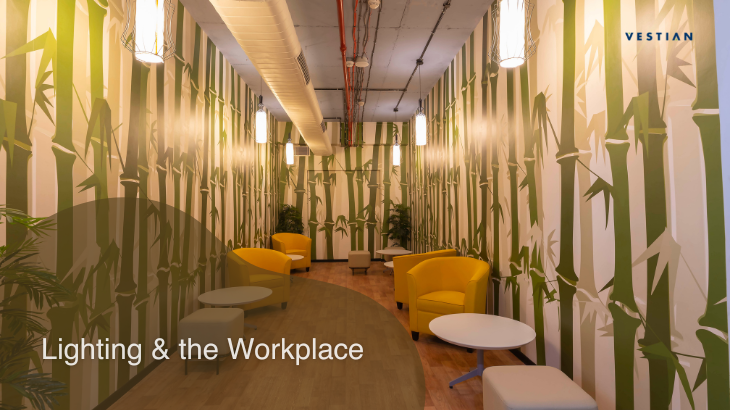It has been proven that lighting has a vital effect on an employee’s productivity & efficiency. Given the physical and psychological effects lighting has on human beings, poor lighting conditions can not only lead to exhaustion, lethargy, irritability, but can also act as a trigger point to raising the incidence of conflicts among employees in high pressure situations. These conditions adversely affect the working environment, degrading overall productivity & efficiency of an organization. Thus, it is no wonder that lighting is given much importance today while designing a workplace.
Our experienced designers, architects and network of lighting professionals can assist organisations create the right ambience for their employees to be at their productive best. According to workspace requirement, lighting layout is designed in such a way that distribution of lighting is given significance in design stage to avoid challenges that improper lighting brings forth.
Our design team has created world class workspaces that apart from being aesthetically unique, also enhance the standards and productivity of the client workplace. This can be anything between addressing insufficient lighting challenges, by way of understanding the kind of task to be performed and planning lighting options commensurate to the type of tasks being performed, to balancing contrast, negating glare through position of light fixtures, use of different types of light fixtures, with varying lux levels.
In recent times, we have helped a large conglomerate in the agri trading business to successfully implement HCL. Human Centric Lighting (HCL)., compensates for the lack of daylight and contributes to the natural circadian rhythm of humans, adjusting to people’s daily rhythms and improving a person’s motivational level, well-being and productivity. The science behind this concept is fairly direct – creating lighting solutions that bear an impact on the mood, productivity and enhance the user’s experience of the space, through mimicking body’s natural circadian rhythm.
Application of IoT in Lighting is another option that is gaining widespread acceptance in the recent times. Enhanced with sensors and embedded microchips, detecting and interacting with its environment in real-time, IoT in lighting has proved that intelligent lighting is no more a product but a service. In fact, Lighting system in a workplace coupled with IoT can lead to savings of upto 75% of the existing energy consumption. This system detects occupancy of space & automatically optimizes overall illumination. It turns off the lights as soon as occupiers leave the space and occupant data is collected for further analysis of the lighting requirement. In case of emergencies too, this system intelligently communicates with smoke detectors & alarms, illuminating exit pathways, signages.
Lighting with Li-Fi
Smart lighting fixtures enabled with LiFi offer illumination and secure wireless connectivity in workspaces. LiFi is a technology that provides high speed bi-directional network and mobile communication of data using light. LiFi comprises of multiple bulbs that form a wireless network, offering a substantially similar user experience like a WiFi network. Using light, network access can also be controlled more effectively. For example, overhead lighting in an office can provide access to the guest network, while desk lamps can provide access to specific parts of a corporate network with access rights assigned on a desk-to-desk basis. LiFi is a good alternate to the existing Wifi as it is much faster, efficient and cost effective. In terms of security, it makes use of visible light spectrum and cannot penetrate through optically opaque objects like walls. This restricts unauthorized access, making it a safer alternative to WiFi.
Sustainable lighting
Growing emphasis on sustainable design trends is also impacting the way lighting solutions are being designed/ created. Architects are including lighting solutions that are energy-efficient, made from sustainable practices and materials, that have minimal impact on the environment. We see companies investing in reducing the plastic parts within the assembled product, replacing them with recycled and recyclable materials.
Lighting trends beyond imagination
Today, lighting trends too have evolved with the changing requirements. Even if you don’t have access to a proper window at home, you can still have the luxury of enjoying sunlight, albeit an artificial one, through a window shaped device. That is Samsung’s SunnyFive, a fake window that provides a full spectrum of natural lighting, allowing it to change directions throughout the day, much like natural light.
This is just one example of innovation in lighting. What is relevant is that lighting solutions are moving away from the traditional to incorporate environmentally sustainable and technologically advanced options.
